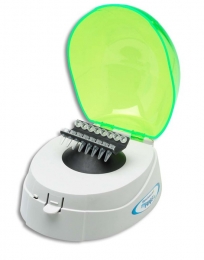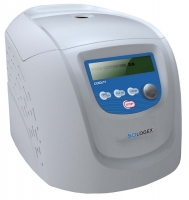Application. Functionality. Size. These three factors are critical in determining which centrifuge is right for you. You’re probably wondering: what is a centrifuge? Centrifuges are machines that apply a centrifugal force (a force that pushes outwards on an object moving around the center) to a container which causes the container to spin rapidly. Typically if you are looking for a machine that has the ability to separate liquids of different densities or a liquid from a solid, a centrifuge is ideal for those applications.
Centrifuges come in 5 different types varying in size, speed and what they are commonly used for. The most basic and smallest model is the mini centrifuge. They are also referred to as a spin-down centrifuge. Mini centrifuges are table top units. They are so light that they can be held with just one hand. Mini centrifuges are able to hold tubes between .2 to 2.0 milliliters. This model can spin up to 6,000 rpm. Mini centrifuges are often used in environmental and clinical science for the basic separation of samples.Similar to mini centrifuges, clinical centrifuges are also compact table top units and spin at low speeds of 6,000 rpm. The main difference between these two types of centrifuges is the clinical centrifuges are designed to hold the tubes horizontally instead of vertically. This design allows for better separation of the samples. Some of the clinical centrifuges also have the feature of a swing out rotor. This means that model has mobile tube holders that hold the tubes vertically when the rotor is not in use. When the rotor is in motion, the tube holders move the tubes into the horizontal position. The swing out rotor is used for blood samples because the capacity of the tube holders is between 5 to 15 milliliters instead of .2 to 2 milliliters. Clinical centrifuges can often be found in hospitals and diagnostic labs.
For many types of molecular biology and biochemistry applications, microcentrifuges are often used. These centrifuges offer the ability to adjust the rpms and have time settings. The maximum speed for these models is 60,000 rpm. Microcentrifuges are also able to fit tubes between .2 and 2 milliliters.
The larger version of the microcentrifuge is called the bench top centrifuge. With these models, it is important to take into consideration how much space you have available. They tend to be bulky and take up a lot of bench space. The speed settings and time can be adjusted for these centrifuges. They also are able to reach a speed of 100,000 rpm.
The most impressive type of centrifuge is the ultracentrifuge. They have the ability to spin up to speeds of 1,000,000 times the force of the earth’s gravity! These models are large in size and are stand alone units. Ultracentrifuges are about the size of a washing machine. There are two categories of ultracentrifuges, they include analytical and preparative. Analytical ultracentrifuges come with fixed rotors and an optical detection system that can analyze samples as they spin. Their ability to analyze samples as they spin makes them great for sedimentation studies in the environmental and chemical fields. Preparative ultracentrifuges come with swing out rotors which makes them perfect for gradient separation applications in biology and biochemistry.
What do you think about our post on centrifuges?


Leave a Reply